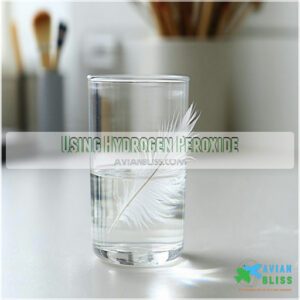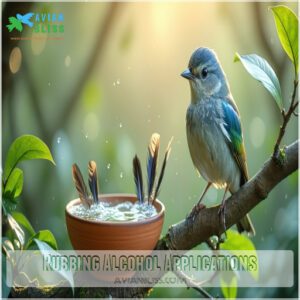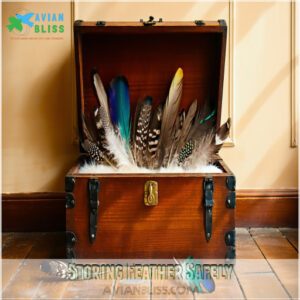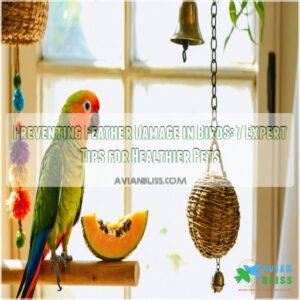This site is supported by our readers. We may earn a commission, at no cost to you, if you purchase through links.
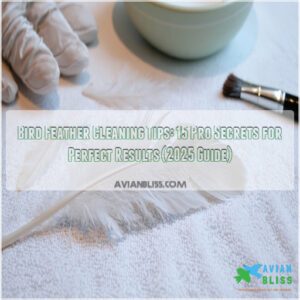
Start by gently brushing away debris with a specialized feather brush, working from base to tip. Don a pair of gloves to protect the feathers from your skin’s natural oils.
Create a cleaning solution using mild, unscented detergent and lukewarm water. For thorough sanitization, mix equal parts hydrogen peroxide and rubbing alcohol.
After cleaning, air-dry your feathers on a clean towel or use a hairdryer on cool setting. Store them in airtight containers with natural repellents like cedar or lavender to keep pests at bay.
The secret to professional-grade results lies in the details.
Table Of Contents
- Key Takeaways
- Cleaning Feather Basics
- Sanitizing Feather Methods
- Drying Feather Techniques
- Storing Feather Safely
- Handling Feather Precautions
- Frequently Asked Questions (FAQs)
- How do you keep a bird’s feathers clean?
- Do indoor pet birds clean their feathers?
- How to improve feather quality in birds?
- How do you clean a cat’s feathers?
- How do you clean feathers with dish soap?
- How do you sanitize feathers?
- What is the best way to clean bird feathers?
- What is the best way to wash a feather?
- Can you clean feathers with Dawn dish soap?
- How do you clean poop off bird feathers?
- Conclusion
Key Takeaways
- You’ll need gentle tools to start cleaning – use a specialized feather brush and comb to remove debris, working from base to tip while wearing gloves to protect feathers from skin oils.
- You can create an effective sanitizing solution by mixing equal parts hydrogen peroxide and rubbing alcohol, which kills viruses, bacteria, and parasites while preserving the feather’s structure.
- You’ll want to dry your feathers carefully – either air-dry them on a clean towel or use a hairdryer on cool setting, keeping it 12 inches away to prevent damage to the delicate barbules.
- You should store your cleaned feathers in airtight containers with natural repellents like cedar or lavender, which will protect them from moisture and pests while maintaining their condition long-term.
Cleaning Feather Basics
You’ll need to master some essential cleaning techniques before you can transform those dirty bird feathers into beautiful decorative pieces.
Whether you’re working with found feathers or ones from your pet bird, you’ll learn how to safely remove dirt and parasites using the right cleaning solutions without damaging these delicate natural treasures.
Removing Dirt and Debris
Before you start cleaning those beautiful feathers, you’ll need to tackle the initial dirt removal phase with precision. Using a feather comb, gently brush away loose debris and dust in one direction – working from base to tip. Think of it as giving your feathers a spa treatment!
- Start with a specialized feather brush to sweep away surface grit without damaging delicate barbs
- Use short, gentle strokes with a feather comb to dislodge stubborn dirt particles
- Remove larger debris by hand while wearing protective gloves to avoid oils from your skin
For effective cleaning, consider using tools designed for feather cleaning tasks.
Using Mild Detergent Solutions
Now that you’ve cleared away the surface debris, let’s mix up your feather cleaning solution.
You’ll want to use a mild, unscented detergent – baby shampoo works wonders!
Mix one teaspoon with a cup of lukewarm water.
The gentle soap solution helps break down oils without damaging delicate barbs.
Test the temperature on your wrist – it should feel comfortable, just like testing baby bath water.
Avoiding Excessive Moisture
Keep those feathers looking pristine by mastering moisture control during cleaning.
You’ll want to avoid soaking them completely, as excess water can destroy the delicate barbules that give feathers their structure.
For best feather health, consider following best care tips.
Instead, use gentle handling techniques with a barely damp cloth for spot cleaning.
Proper air circulation is key – think of it like giving your feathers a spa day without the swimming pool, which is crucial for maintaining their health and appearance, and remember to handle them with care to prevent damage to the delicate barbules.
Sanitizing Feather Methods
You’ll need to properly sanitize your feathers to protect against harmful parasites and diseases that wild birds often carry.
A mixture of hydrogen peroxide and rubbing alcohol will effectively kill viruses, bacteria, and microscopic bugs while keeping the feathers safe for handling, using a method that involves rubbing alcohol.
Using Hydrogen Peroxide
After getting those feathers squeaky clean, it’s time to tackle any lingering germs.
Mix one part hydrogen peroxide with nine parts water for a powerful sanitizing solution. You’ll want to gently soak your feathers in this mixture – it’s a pro feather cleaning tip that really works.
The solution’s virucidal and bactericidal properties will effectively disinfect your feathers while keeping their natural beauty intact.
To prevent future damage, consider learning about feather care methods to properly maintain your feathers, using pro feather cleaning tip and understanding the importance of feather care.
Rubbing Alcohol Applications
Building on your hydrogen peroxide solution, mix it with rubbing alcohol (70% isopropyl or higher) for maximum cleaning power. This dynamic duo doesn’t just sanitize your feathers – it’ll make them shine brighter too.
Create a 50-50 mixture and watch it work its magic. You’ll love how this powerhouse combo tackles both mites and viruses while brightening your feathers’ natural colors.
For effective feather cleaning, always check the feather sanitizing methods before proceeding, ensuring you’re using a proven method.
Virucidal and Bactericidal Properties
Beyond rubbing alcohol’s cleaning power, you’ll want to harness its virucidal and bactericidal properties.
When you mix hydrogen peroxide with rubbing alcohol in equal parts, you create a powerful disinfectant method that kills both viruses and bacteria.
This antimicrobial agent penetrates deep into feather fibers during sanitization.
For ideal germ removal and bacterial control, soak your feathers in this solution for at least 30 minutes.
Understanding the role of bird feather structure is essential for effective cleaning and maintenance.
Drying Feather Techniques
You’ll need to master the right drying techniques to protect your feathers from damage and make sure they maintain their natural shape and flexibility.
Once you’ve properly cleaned your feathers, you can use either gentle air-drying methods or a hairdryer on a cool, low setting to get them ready for your next project, using techniques that help maintain their natural shape.
Air Drying Methods
Once you’ve cleaned your feathers, proper air drying is important for maintaining their natural beauty.
A balanced diet promotes healthy feather growth.
Place them flat on a clean, dry towel in a well-ventilated area where air flow can work its magic, giving your feathers a gentle spa day.
Check your feather racks periodically during the drying time, and inspect for any dampness before storing.
Using Low Heat Settings
While air drying works well, sometimes you’ll need quicker results.
Your hair dryer can be a game-changer for gentle drying – just remember these feather cleaning tips:
- Keep the dryer at least 12 inches away to prevent damage
- Use only the lowest heat setting or cool air mode
- Move the dryer continuously to distribute heat evenly
For best feather care, alternate between dry cleaning with the hair dryer and letting feathers rest naturally.
Straightening Bent Quills
After your feathers are dry, it’s time to tackle those pesky bent quills. You’ll need tweezers and steady hands for proper feather reshaping.
Here’s a handy guide for your quill repair needs:
| Quill Condition | Straightening Method | Time Needed |
|---|---|---|
| Slightly Bent | Steam + Gentle Press | 2-3 minutes |
| Moderately Curved | Warm Water Soak | 5-7 minutes |
| Severely Twisted | Heat + Gradual Press | 8-10 minutes |
| Split Ends | Trim + Reshape | 4-5 minutes |
| Crimped Areas | Steam + Massage | 3-4 minutes |
Use gentle pressure while preening – you’re fixing feathers, not playing tug-of-war! Remember to be careful and patient, as proper feather reshaping requires attention to detail.
Storing Feather Safely
You’ll want to keep your cleaned feathers in a sealed container or plastic bag to protect them from sneaky insects and harmful moisture that can quickly ruin your collection.
For extra protection against pesky bugs, you can store your feathers in a cedar chest, where the wood’s natural oils work like nature’s own bug spray, providing extra protection.
Sealing Feathers Tight
Now that your feathers are completely dry, proper storage will keep them pristine.
Start by placing them in airtight containers – zip-top bags work great for feather storage, but make sure to squeeze out excess air first.
Here’s why tight sealing matters:
- Prevents moisture from sneaking in and causing mold growth
- Keeps dust and debris from settling on your cleaned treasures
- Creates a barrier against unexpected household spills
Remember to label each container with the date for better feather maintenance tracking, which is crucial for long-term preservation.
Repelling Insects Naturally
Once you’ve sealed your feathers, protect them with nature’s own pest control.
Natural oils and herbal repellents work wonders against bird parasites and feather mites.
Try placing mint leaves around your stored feathers – mosquitoes hate the smell!
Essential sprays made from lavender or citrus can create an invisible shield.
For best results, combine different natural repellents to keep those unwanted visitors at bay, using methods that are a form of invisible shield.
Using Cedar Chests
While natural repellents work well, a cedar chest offers the ultimate feather sanctuary.
Cedar oil’s potent aroma acts as a natural moth and mite deterrent, similar to mothballs but without harsh chemicals.
You’ll want to maintain your chest’s aromatic properties by lightly sanding the wood surface yearly.
For best results, store your cleaned feathers in acid-free tissue paper before placing them in your cedar chest.
Proper cedar chest feather storage is important for maintaining the quality of your feathers, which involves using effective cedar chest solutions.
Handling Feather Precautions
You’ll need more than just soap and water to handle bird feathers safely, as these natural treasures can carry microscopic parasites and potentially harmful bacteria.
Before you start cleaning those beautiful plumes, protect yourself with rubber gloves, a face mask, and protective eyewear to prevent exposure to airborne particles that could make you sick, and remember to handle them with care to avoid airborne particles.
Wearing Protective Gear
Everyone knows safety comes first when handling bird feathers.
You’ll need proper protective gear: thick rubber gloves to shield your hands from parasites, wraparound goggles to protect your eyes from floating particles, and a well-fitted respirator mask for respiratory safety.
Don’t skip hand sanitizer between glove changes, while it might feel like overkill, proper feather cleaning requires this full armor – better safe than sorry!
Preventing Airborne Infections
Your health’s guardian angel is a simple face mask, acting as your first line of defense against airborne infections when handling feathers.
You’ll want to pair respiratory safety with proper air purification – keep windows open or use a fan for ventilation.
Disease transmission from feathers isn’t just theoretical; birds can carry pathogens that become airborne during feather screening and sanitization processes.
Don’t skip the mask, as it is crucial for preventing the spread of diseases that birds can carry, making it your first line of defense.
Killing Microscopic Parasites
Microscopic parasites lurking in feathers can wreak havoc on your collection. Here’s how to wage war on these tiny troublemakers: you’ll need freezing temperatures or a potent mix of alcohol and peroxide for effective pest eradication.
Understanding feather health basics is essential for maintaining healthy feathers and preventing parasite infestations.
To eradicate parasites, follow these steps:
- Place feathers in a freezer at 0°F for 48 hours
- Mix equal parts rubbing alcohol and hydrogen peroxide
- Soak feathers for 30 minutes
- Steam feathers to eliminate surviving mites
- Store in cedar chests for natural protection, utilizing potent mix of treatments for optimal results.
Frequently Asked Questions (FAQs)
How do you keep a bird’s feathers clean?
You’ll want to wipe feathers gently with mild soap and warm water, pat dry with a towel, and use a low-heat hairdryer.
Don’t forget regular grooming and misting to maintain your bird’s plumage.
Do indoor pet birds clean their feathers?
Yes, your indoor pet birds naturally clean their feathers through preening – they’ll spread protective oils from their preen gland and remove dirt with their beaks.
You’ll often see them grooming throughout the day.
How to improve feather quality in birds?
Your feathered friend’s plumage will shine when you provide a balanced diet, regular baths, proper humidity, and vitamin supplements.
Don’t forget to mist them daily and make sure they get enough sunlight for ideal feather health, which is crucial for their overall well-being, and also ensure proper humidity.
How do you clean a cat’s feathers?
Cats don’t have feathers – they’re mammals with fur.
If you’re looking to clean your cat, use pet-specific shampoo and warm water, or take them to a professional groomer for the best results.
How do you clean feathers with dish soap?
Mix lukewarm water with gentle dish soap, dip feathers briefly, and wipe softly with a cloth.
You’ll want to rinse thoroughly with clean water, then pat dry and let them air-dry completely.
How do you sanitize feathers?
Soak your feathers in a 50-50 mix of rubbing alcohol and hydrogen peroxide to kill germs. You’ll need to let them air-dry completely in a well-ventilated area after the treatment.
What is the best way to clean bird feathers?
Begin by soaking feathers in lukewarm water with mild detergent.
You’ll want to gently wipe them with a soft cloth, then sanitize using a 50-50 mix of rubbing alcohol and hydrogen peroxide.
Let air-dry completely.
What is the best way to wash a feather?
Practice makes perfect when cleaning feathers.
Mix lukewarm water and mild detergent, gently wipe with a soft cloth, avoiding excessive moisture.
Can you clean feathers with Dawn dish soap?
You’ll get great results using Dawn dish soap.
Create a gentle solution with lukewarm water, but don’t scrub too hard.
You can softly wipe the feather clean and rinse thoroughly to avoid soap residue, using a gentle solution.
How do you clean poop off bird feathers?
Like wiping a window clean, you’ll want to dampen the soiled feather with lukewarm water and mild soap.
Gently wipe with a soft cloth, then rinse and pat dry with paper towels.
Conclusion
Mastering these bird feather cleaning tips transforms a delicate task into a rewarding hobby.
You’ll find that proper cleaning also maintains these natural treasures and reveals their hidden beauty.
Whether you’re a collector, crafter, or nature enthusiast, these methods guarantee your feathers stay pristine for years to come.
Remember, patience and attention to detail make all the difference.
With these professional techniques in your toolkit, you’re well-prepared to handle any feather cleaning challenge that comes your way.
- https://www.featherfolio.com/blog/guide-to-feather-cleaning-and-care
- https://www.reddit.com/r/SASSWitches/comments/otfvqy/cleaning_found_feathers_for_safe_use/
- https://www.wikihow.com/Clean-a-Feather
- http://birdmites.org/
- https://www.cdc.gov/infectioncontrol/guidelines/disinfection/disinfection-methods/chemical.html


